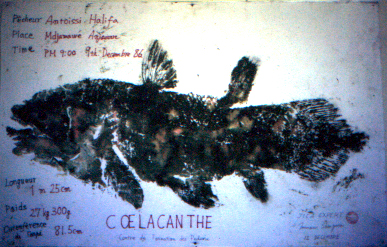Recollections of the Past 30 years pursuing Coelacanths
Jerome Hamlin, creator dinofish.com
In those days, communications between the Comoros and NYC were by letter or telex, although there was the possibility of a very expensive international phone call. Telexes would come from the U.S. consulate in Moroni to Arn's company in New Jersey, and then be relayed to me for my response in the reverse direction. (In fact, Arn's important role in the project's communications helped to make him a director of the Explore's Club.) The Explorers Club heirarchy was also supportive during the controversy, although they really didn't know what to do about it. As 1988 wore on, back in NYC I learned that a coelacanth had been caught off the Comorian island of Anjouan, and placed in our decompression cage successfully by divers from the Japanese fishing school on that island. The divers visited the fish from time to time and claim they even fed it. After about a week the fish died, they said from being attacked by an eel. This constituted the longest time a coelacanth had survived after capture and hinted at the viability of the recompression approach to coelacanth recovery. It also showed the need to put a net mesh around the cage . During the same time frame, however, a coelacanth caught off Grand Comoro, had been put in Jean Louis Gerod's chicken wire cage by a French SCUBA club. It had died soon after and was in bad shape when they hauled it ashore. My project would be blammed for that fish under the misconception that we had caused it to be caught and mishandled, although it was an accidental bycatch, and Jean Louis had been putting them in his cage for years before my involvement.

A gyotaku (ink impression) made from a coelacanth caught near the Japanese fishing school on the Comorian island of Anjouan. This traditional technique used to record fish catches, has turned into an art form.
I took an unrelated job filmming in Australia during the summer of '88, but in 1989, as I was editing the Australia film, there was an ominous development. News reached me that Japan's Toba Aquarium was to launch a major expedition to the Comoros to capture and return two living coelacanths, preferably a male and a female, to Japan. The expedition was scheduled for the fall of '89. As so often with these matters, Japan seemed immune to the controversy surrounding the capture issue. I knew I did not have much time before I would have to give up on the whole matter of our project.
In the spring of '89, knowing I would have no outside support, I devised a final preemptive expedition for the early summer of '89. The plan was threefold. First, we would try something new, we would build a coelacanth trap in the Comoros, and see if that worked in terms of catching one with minimum stress. Second, we would fill the innsulated transprter tank still at the consulate warehouse with seawater and set up the life support system there, so that an intercepted fish woud go directly into the cold oxygenated water in the tank, instead of using the decomression cages. And third, we would bring with us acoustical tags, so if a fish was caught while we were there we had the alternative option of tagging it and learning some new behavioral information. By June, all was arranged, and I was ready to go, bringing with me only the son of a former girlfriend with whom I had remained close, to help.
